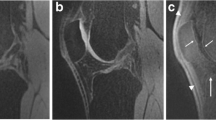Abstract
Human articular cartilage from 16 cadaveric or amputated knees was studied using standard magnetic resonance imaging (MRI), on-resonance magnetization transfer contrast (MTC) and MTC-subtraction MRI. Results were compared with subsequent macroscopic and histopathological findings. MTC-subtraction and T2-weighted spin-echo images visualized cartilaginous surface defects with high sensitivity and specificity. MTC and T2-weighted spin-echo images revealed intra-cartilaginous signal loss without surface defects in 80% of the cases, corresponding to an increased collagen concentration. It is concluded that MTC is sensitive to early cartilage degeneration and MTC-subtraction can be helpful in detecting cartilage defects.
Similar content being viewed by others
References
Adam G, Nolte-Ernsting C, Prescher A, Bühne M, Bruchmüller K, Küpper W, Günther RW. Experimental hyaline cartilage lesions: two-dimensional spin-echo versus threedimesional gradient-echo MR imaging. J Magn Reson Imaging 1991; 1: 665–672.
Reiser MF, Bongartz G, Erlemann R, Strobel M, Pauly T, Gaebert K, Stoeber U, Peters PE. Magnetic resonance in cartilaginous lesions of the knee joint with three-dimensional gradient-echo imaging. Skeletal Radiol 1988; 17: 465–471.
Tervonen O, Dietz MJ, Carmichael SW, Ehman RL. MR imaging of knee hyaline cartilage: evaluation of two- and three-dimensional sequences. J Magn Reson Imaging 1993; 3: 663–668.
Engel A, Kramer J, Stiglbauer R, Hajek PC, Imhof H. Articular cartilage defect detectability in human knees with MR arthrography. Eur Radiol 1993; 3: 161–165.
Gylys-Morin VM, Hajek PC, Sartoris DJ, Resnick D. Articuar cartilage defects: detectability in cadaver knees with MR. AJR 1987; 148: 1153–1157.
Chandnani VP, Ho C, Chu P, Trudell D, Resnick D. Knee hyaline cartilage evaluated with MR imaging: a cadaveric study involving multiple imaging sequences and intraarticular injection of gadolinium and saline solution. Radiology 1991; 178: 557–561.
König H, Sauter R, Deimling M, Vogt M. Cartilage disorders; comparison of spin-echo, CHESS, and FLASH sequence MR images. Radiology 1987; 164: 753–758.
Morris GA, Freemont AJ. Direct observation of the magnetization exchange dynamics responsible for magnetization transfer contrast in human cartilage in vitro. Magn Reson Med 1992; 28: 97–104.
Recht MP, Kramer J, Marcelis S, Pathria MN, Trudell D, Haghighi P, Sartoris DJ, Resnick D. Abnormalities of articular cartilage in the knee: analysis of available MR techniques. Raiology 1993; 187: 473–378.
Hunziker EB. Articular cartilage structure in humans and experimental animals. In: Kuettner K. (eds). Articular cartilage and osteoarthropathy. New York: Raven Press, 1982: 183–199.
Lehner KB, Rechel HP, Gmeinwieser JK, Heuck AF, Lukas HP, Kohl HP. Structure, function, and degeneration of bovine hyaline cartilage: assessment with MR imaging in vitro. Radiology 1989; 170: 495–499.
Modl JM, Sether LA, Haughton VM, Kneeland JB. Articular cartilage: correlation of histologic zones with signal intensity at MR imaging. Radiology 1991; 181: 853–855.
Paul PK, Jasani MK, Sebok D, Rakhit A, Dunton AW, Douglas FL. Variation in MR signal intensity across normal human knee cartilage. J Magn Reson Imaging 1993; 3: 569–574.
Freeman DM, Bergman AG, Glover G, Hurd RE. MR contrast mechanisms for characterization of human cartilage ultrastructure. Proceedings of SMRM XII 1993; 1294
Rubenstein JD, Kim JK, Morava-Protzner I, Stanchev PL, Henkelman RM. Effects of collagen orientation on MR imaging characteristics of bovine articular cartilage. Radiology 1993; 188: 219–226.
Mohr W. Arthrosis deformans. In: Dörr E, Seifert A (eds). Spezielle Pathologie. Berlin Heidelberg New York: Springer, 1984: 277–297
Kim DK, Ceckler TL, Hascall VC, Calabro A, Balaban RS. Analysis of water macromolecule proton magnetization transfer in articular cartilage. Magn Reson Med 1993; 29: 211–215.
Lesperance LM, Gray ML, Burstein D. Effect of collagen conentration and structure on magnetization transfer in hydrated collagen and cartilage. Proceedings of the SMRM XII 1993; 1107
Paul PK, O'Byrne E, Blancuzzi V, Wilson D, Gunson D, Douglas FL, Wang JZ, Mezrich RS. Magnetic resonance imaging reflects cartilage proteoglycan degradation in the rabbit knee. Skeletal Radiol 1991; 20: 32–36.
Author information
Authors and Affiliations
Rights and permissions
About this article
Cite this article
Vahlensieck, M., Dombrowski, F., Leutner, C. et al. Magnetization transfer contrast (MTC) and MTC-subtraction: enhancement of cartilage lesions and intracartilaginous degeneration in vitro. Skeletal Radiol. 23, 535–539 (1994). https://doi.org/10.1007/BF00223085
Issue Date:
DOI: https://doi.org/10.1007/BF00223085




